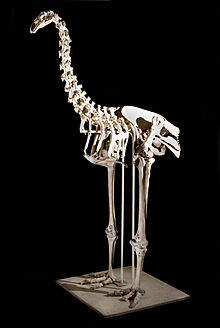| South Island giant moa Temporal range: Late Holocene
| |
|---|---|

| |
| Skeleton, likely of an adult male | |
| Scientific classification | |
| Domain: | Eukaryota |
| Kingdom: | Animalia |
| Phylum: | Chordata |
| Class: | Aves |
| Infraclass: | Palaeognathae |
| Order: | †Dinornithiformes |
| Family: | †Dinornithidae |
| Genus: | †Dinornis |
| Species: | †D. robustus
|
| Binomial name | |
| †Dinornis robustus | |
| Synonyms | |
|
List
| |
The South Island giant moa (Dinornis robustus) is an extinct species of moa in the genus Dinornis, known in Māori by the name moa nunui.[2] It was one of the tallest-known bird species to walk the Earth, exceeded in weight only by the heavier but shorter elephant bird of Madagascar (also extinct).[citation needed]
- ^ Gill, B.J.; Bell, B.D.; Chambers, G.K.; Medway, D.G.; Palma, R.L.; Scofield, R.P.; et al. (2010). Checklist of the Birds of New Zealand, Norfolk and Macquarie Islands, and the Ross Dependency, Antarctica (PDF) (Report) (4th ed.). Ornithological Society of New Zealand / Te Papa Press. Retrieved 30 October 2022 – via nzbirdsonline.org.nz.
- ^ Doyle, Trent (15 November 2023). "Scientists reveal fossilised moa footprints in Otago are at least 3.6 million years old". Newshub. Retrieved 23 February 2024.